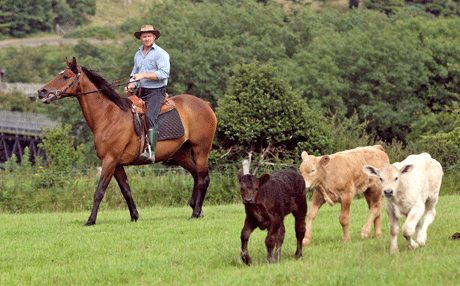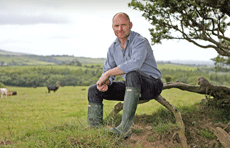FW Awards finalist: Came back fighting after foot-and-mouth

Philip Heard
Meldon Farm, Okehampton, Devon
To come back from losing your entire livelihood through foot-and-mouth is no mean feat, one that some producers have never done. But Dartmoor suckler producer and Beef Farmer of the Year finalist Philip Heard has come back fighting and more determined than ever to produce the best beef he can.
And no one should be more proud of his success than Philip himself. In those seven years he has taken over the farm from his parents and spent a huge amount of energy, determination and sheer bloody mindedness to rebuild the business. He’s reinvested in buildings, equipment and livestock to number 340 upland and lowland suckler cows, including Welsh Blacks, a small herd of pedigree Charolais cattle and an 800-ewe flock.
With labour at a premium, Philip runs the farm himself with one other employee. “It’s essential either he or I can do all the work ourselves. But I’m fortunate to have three sons, one of whom leaves school this summer and is keen to return to the farm.”

The suckler herd is based on a lowland herd of predominantly 215 Limousin x Holstein Friesian cows. Alongside he runs 125 Welsh Black cows, split into autumn and spring calving.
A recently introduced herd health programme has identified a number of issues, such as Johne’s disease, calf pneumonia, iodine deficiency and hypermag. “No cost is incurred without an ultimate benefit, so any suggested vaccination goes through a risk assessment programme to justify cost against risk and ultimate benefit.”
The terminal sire breeding policy is based around producing an exact product for the market Philip aims for – marketing quality suckled calves at designated sales in the south west. “The focus is to get the calf to peak at time of sale, with close attention paid to 200-day weights and conformation.”
Cow management is simple, with autumn-calving cows fed a TMR through a feeder wagon costed at £1.10 a day, while calf creep consists of a 16% protein mix based on oats, sugar beet, soya, molasses and minerals. “This ration worked out at £124/t for 2007/08,” he says.
Before selling, calves are given 2kg a day of a wheat-based feed to maintain condition and add bloom. October sale steers averaged £538, while heifers averaged £465. November sale figures for six-month-old calves averaged £438 for steers and £340 for heifers.
The Welsh Blacks fit well with the environmental constraints. And it’s as a result of these requirements that sees Philip carrying out one of his favourite pastimes. “Due to the rocky and steep terrain, I prefer to do most of my shepherding and herding on horseback, not only is it therapeutic, it’s economical as well.”
Male calves from this herd are kept entire and sold in May, while cross heifers are sold in May and purebreds are retained.
The whole farm is in an HLS agreement, while the common is in an ESA. Philip is also in the Traditional Breed Incentive Scheme with DEFRA, as well as the Sheep Wildlife Enhancement Scheme.
With muck, slurry and water considered as valuable commodities, he uses slurry rather than artificial fertiliser and has converted the supply of mains water to spring, drainage and rainwater. “With 700 cattle housed for a six-month winter on straw yards or in cubicles, this has proved a sound financial move.”

In recent years, Philip has opened the farm gates to NBA and Beef South West farm walks. He and his horse have appeared in many farming publications and although it’s one media item the Heard family rarely talk about, Philip featured in the F&M crisis video shown on Channel 4 during 2001.
As with the rest of the business, Philip is building for the long-term future, and while there is no room for sentiment in his management decisions, it’s quite clear the emotion, trauma and turning point for his family in 2001 still haunts him and drives his determination onwards.
Farm facts
- Farming 283ha (700 acres) on Dartmoor and grazing rights on Dartmoor commons
- Running lowland and upland suckler herds totalling 340 cows and 800 ewes
- Producing suckler calves for sale in autumn and spring at premium prices through local markets
What the judges liked
- Strong analysis of every management, financial and breeding decision
- Markets what customer wants
- Building for long-term future of his family
- Advocate for surrounding environment
